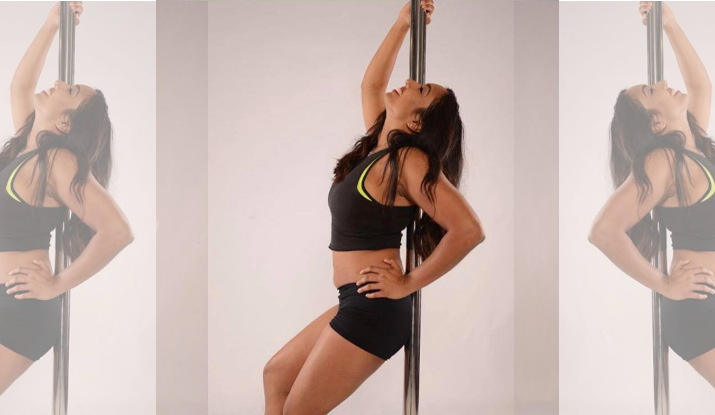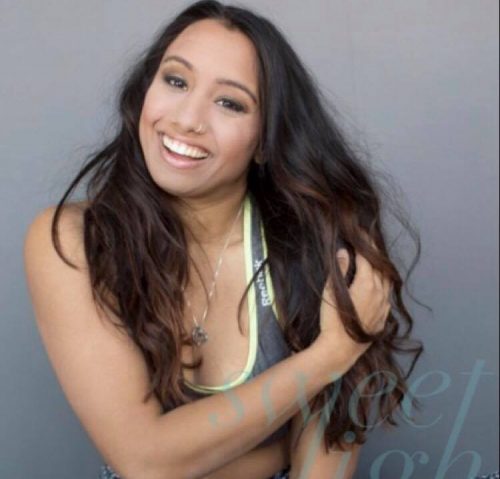
by Karishma Sharma – Follow @kaysharmaa
Preface
It was a warm summer Sunday morning, as I browsed the class catalog online for one of the studios at which I teach Bollywood dance and fitness. I was nervous as I scrolled through the details of pole dance, aerial arts, and more.
“Can my body really do this? What will people think?”
I remember going back forth for 20 minutes, texting friends, calling my sister, not sure what to do. After several conversations and Google searches later, I decided to give it a shot – I signed up for eight weeks of Pole Dance instruction.
This wasn’t just a workout class, this was technique, with a performance at the end. I didn’t know what to expect, but I was ready to go, to try something new.
Week 1: Bruises and Badassery
On the first day, I looked up at my pole, not knowing what to expect. We started off with some warmups and stretches and eventually got to some basic moves. These include a pole sit (sitting on the pole with one leg crossed over another), a pole climb (climbing up the pole), and some basic spins. I let go of all thoughts and simply worked on learning. I remember leaving thinking about how fun it was, but how the thigh burn was real. This was not going to be an easy eight weeks. By the second day of week one, I started to get the hang of things, but boy oh boy, was I bruised. I felt confident, brave, and most importantly – empowered.
Week 2: Things are Looking Up
By week two, I was excited on pole dance days and couldn’t wait to get to the studio. I had a tough time with some moves, as they started to get a bit more difficult, but I kept going. A big thing I learned was to focus on myself, not others around me, as everyone learns at a different pace. I started to get the swing of the pole sit and pole climb a bit and started to get more momentum on my spins. Things were definitely looking up.
[Read Related: Hate Running? 5 Innovative Ways to Still Get in Your Cardio!]
Week 3: Strength Building
By week three, I was pretty much shocked at how long I could hold poses and hold myself up on the pole. I felt so strong and so empowered. I started lifting heavier at the gym, even, because I just felt stronger and my arms could take more. This was the week I realized that pole dancers are some of the strongest athletes out there. To handle the burning and bruising, to hold themselves up for minutes at a time, it’s incredible. I was happy with my results and was seeing the workout side as well as technique.
Week 4: Upside Down, Dancing on the Ceiling
Week four entailed the scariest move of pole dancing for a beginner, the invert. This is where you line up next to the pole, and rotate backward, hook your legs at the upper half of the pole and come back down sliding. I got this on my first try, so I was excited about that. It took a toll on me fast, with blood rushing to my head and needing a long break because I was getting lightheaded. However, I was really excited to have achieved a difficult move, where we eventually let go of the pole and dangled in an “inverted crucifix.” It wasn’t easy, but I was really happy with how it turned out.
Week 5: I’m Never Leaving
Week five was when I was literally waiting for pole days to come. Twice a week wasn’t enough. I was hooked to the adrenaline of learning and mastering new moves, of perfecting old moves, and of continuing my pole education. I was so happy and felt a high of just being there, in the pole studio. I felt that this type of dance was made for me and couldn’t wait to continue my advancement.
[Read Related: Get Fit While Having Fun with These 5 Couples’ and Partner Workouts]
Week 6: What Just Happened?
Week six was a setback. The moves got progressively harder and I couldn’t do them. I started to question things and get frustrated. My instructors told me that there were always days like this. Days where you couldn’t hit every move, where things got difficult, but to power through it and keep going is the best way to continue. If you give up and lose momentum, you won’t be able to pick up where you left off. I took their advice and kept fighting through. By the end of the second day, I started to see some progress and felt relieved. I was nervous my streak was over.
Week 7: Happiness is the Pole
On week seven, everything re-clicked for me. Learning choreography was such an amazing experience, putting moves together with song, and getting a lyrical aspect of the pole. It was really enjoyable. I felt so happy to have started this journey and I didn’t want it to end.
Week 8: I am a Pole Dancer
My heart was heavy that it was over, but performing was the best experience. I was so grateful and still am for all that I have learned and definitely plan to continue my pole dance education. This was truly something that I will never forget.
Karishm a Sharma is a Bollywood Dance Fitness Instructor based in Minneapolis, MN. Her biggest hobby, her passion, and her dedication are all to fitness. She is also a dancer and is passionate about spreading her culture to those who may not be familiar. She aspires to keep her love of fitness alive each day in everything she does!
a Sharma is a Bollywood Dance Fitness Instructor based in Minneapolis, MN. Her biggest hobby, her passion, and her dedication are all to fitness. She is also a dancer and is passionate about spreading her culture to those who may not be familiar. She aspires to keep her love of fitness alive each day in everything she does!




